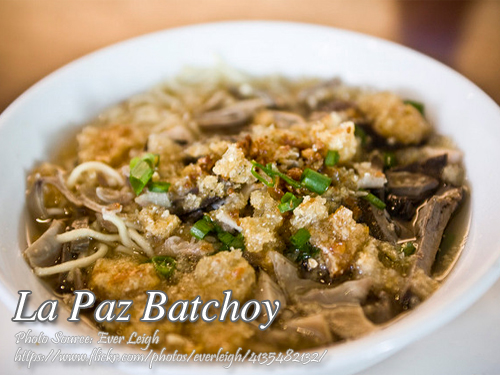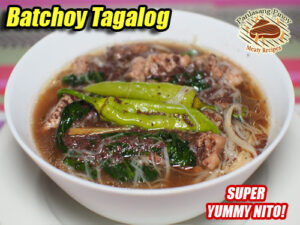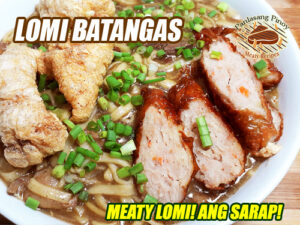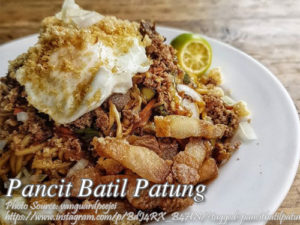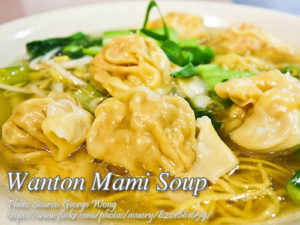This noodle dish is one of the popular Filipino soup dish which originated in La Paz, Iloilo City. The La paz batchoy is similar to chicken mami noodles but the only difference is the generous meat toppings like pork, chicken and pork liver with the garnishing of crushed pork chicharon (pork rind cracklings) and spring onions and the addition of shrimp paste. This is actually a very simple dish which is quick and simple.
The only process that takes a long time is making the soup stock which requires 2 to 3 hours boiling the pork or beef bones. As much as possible choose bones with marrow, meat and tendons to make the broth more tasty and appetizing. The taste of your La Paz batchoy will depend on the kind of soup stock you will use. The noodles used in the traditional batchoy is miki noodles but I think you can also use other kinds of egg noodles if miki is not available.
La Paz Batchoy: A Taste of Iloilo’s Heart and Soul
If you’ve ever strolled through the bustling streets of La Paz, Iloilo City, the aroma of La Paz batchoy wafting from local eateries is unforgettable. This iconic noodle soup is more than just a dish; it’s a bowl of tradition, warmth, and nostalgia. Growing up, I remember my uncle, Tito Ben, telling me stories of how he would sneak into the market during siesta hours just to enjoy a bowl of this comforting delicacy. Inspired by his tales, I’ve embraced the art of making batchoy, and every time I prepare it, it feels like a connection to family, history, and home.
What Makes La Paz Batchoy Unique
La Paz batchoy is often compared to chicken mami noodles, but the distinction lies in its rich, flavorful toppings and hearty broth. The base is a labor of love: a stock simmered for hours with pork or beef bones, ideally those with marrow, tendons, and bits of meat clinging to them. This slow process extracts every ounce of flavor, creating a broth that’s both robust and deeply satisfying.
Unlike other noodle soups, batchoy is generously adorned with pork, chicken, liver, shrimp, and a crown of crushed pork chicharon. These toppings, paired with the subtle brininess of shrimp paste and the fresh zest of spring onions, make each bite a delightful medley of textures and tastes.
In our family, miki noodles—thick, yellow egg noodles—are the preferred choice. Tito Ben always said that their slightly chewy texture holds up beautifully in the rich broth. If you’re in a pinch, other egg noodles can work, but nothing quite matches the authenticity of miki.
The Secret to a Perfect Broth
Making the soup stock is the soul of this iconic noodle dish, and this step demands patience. My lola, Nanay Mila, used to say, “The longer you simmer, the better the broth.” She wasn’t wrong. By boiling fresh pork or beef bones for two to three hours, you coax out a depth of flavor that shortcuts simply can’t replicate.
Adding aromatics like onion, garlic, and peppercorns enhances the broth, while soy sauce, shrimp paste, and Worcestershire sauce give it the signature umami punch. Each ingredient has a role to play. For instance, shrimp paste adds a subtle brininess that cuts through the richness, while Worcestershire sauce lends a tangy depth that balances the flavors.
A Family Tradition with a Modern Twist
For us, preparing La Paz batchoy has become a cherished family activity. My sister, Liza, insists on peeling the shrimp, joking that it’s her contribution to the “culinary masterpiece.” Meanwhile, my cousins eagerly wait to crush the pork chicharon into fine bits—arguably the most exciting part of the process.
But as with any dish, there’s room for a little improvisation. While pork and chicken are traditional, some cooks experiment with beef or even seafood for a unique twist. My cousin, Mark, once added squid rings, and though unconventional, it gave the batchoy a delightful coastal flair.
Serving La Paz Batchoy: A Feast for the Senses
When it’s time to serve, the assembly is almost ceremonial. The miki noodles go into the bowl first, followed by the steaming broth. Thin slices of pork, chicken, and liver are artfully arranged on top, alongside plump shrimps. Finally, the garnishes: a generous sprinkle of crushed chicharon, a scattering of fried garlic, and a handful of chopped spring onions.
My nephew, Carlo, always says, “The chicharon is the best part!” It’s hard to disagree. Its crunchiness provides the perfect contrast to the soft noodles and tender meat, creating a harmony of flavors and textures.
A Slice of History in Every Bowl
La Paz batchoy traces its roots back to the 1930s, credited to Federico Guillergan Sr., who began serving this hearty noodle soup at a small carinderia in La Paz Market. Over the decades, it has become a symbol of Iloilo’s culinary heritage. Each bowl tells a story of resilience, creativity, and love for local ingredients.
When you enjoy a bowl of this dish, you’re not just savoring a meal; you’re experiencing a slice of Filipino history. It’s no wonder this dish has become a favorite for Filipinos and foreigners alike.
Food for Thought
Did you know that the term “batchoy” may have come from the Chinese word “ba chui,” meaning meat soup? This reflects the dish’s possible Chinese influence, blending seamlessly with local flavors to create something uniquely Filipino.
Make It Your Own
La Pazbatchoy may have its roots in Iloilo, but its heart belongs to every kitchen willing to prepare it. Whether you’re following tradition or adding your twist, the key is in the broth and the love you pour into making it.
So, the next time you’re craving comfort in a bowl, give La Paz batchoy a try. Gather your family, share stories over steaming bowls of this savory noodle soup, and create memories that will last a lifetime. After all, that’s what food is all about—bringing people together.
How to Cook La Paz Batchoy
Ingredients
- 1 kilo mami noodles blanch for a minute and drain
- 1/4 kilo pork belly
- 150 grams pork liver
- 150 grams shrimps
- 200 grams chicken breast
- 1 onion quartered
- 6 cloves garlic crushed
- 1/2 tsp. shrimp paste bagoong
- 1 tsp. peppercorns crushed
- 2 Tbsp. Worcestershire sauce
- 11 to 12 cups soup stock from boiled beef or pork
- 1 Tbsp. sugar
- 1 tsp. soy sauce
- salt to taste
- chopped garlic fried (for garnishing)
- chopped spring onion for garnishing
- chicharon crushed (for garnishing)
Instructions
How to make La Paz Batchoy:
- To make a soup stock, boil fresh pork or beef bones (with marrow and some meat) in about 20 cups of water for about 2 to 3 hours.
- In a large cooking pot, pour 11 to 12 cups of soup stock and add onion, garlic, shrimp paste, peppercorns, Worcestershire sauce, sugar, soy sauce and salt. Bring to a boil.
- Put in the shrimps and let it simmer until cooked. Remove the shrimps from the pot. Remove the head and peel. Set aside.
- Put the liver and cook for about 7 minutes. Remove from the broth and set aside.
- Put the pork and chicken in the pot and let it simmer until the pork is tender for about 20 minutes. Remove the meat from the pot and let it cool. Debone the chicken breast and slice into thin strips. Do the same with the pork and liver.
- Season the broth with salt and pepper. Continue simmering until ready to serve. Add more broth if necessary.
- Serve in individual bowls containing the desired amount of miki noodles. Pour broth and top with chicken, pork, shrimps and liver. Garnish with chicharon, spring onion and fried garlic. Serve hot.
Notes
Cooking Tips:
Choose the Right Bones for a Flavorful Broth
For the best-tasting broth, use pork or beef bones with marrow, tendons, and bits of meat attached. The marrow adds a creamy richness, while the tendons contribute a silky texture to the soup. Simmering these bones for 2 to 3 hours allows the flavors to fully develop, creating a robust base for your batchoy.Perfect the Balance of Seasonings
Shrimp paste, soy sauce, and Worcestershire sauce are key to achieving the signature umami flavor of th dish. Add these ingredients gradually, tasting as you go to avoid overpowering the broth. A well-balanced combination ensures every spoonful is savory, aromatic, and delicious.Don’t Skip the Garnishes
The garnishes—crushed pork chicharon, fried garlic, and spring onions—add essential layers of flavor and texture to the dish. The chicharon provides crunch, the garlic offers a fragrant depth, and the spring onions lend freshness. These toppings elevate the dish from a simple noodle soup to a memorable culinary experience.
